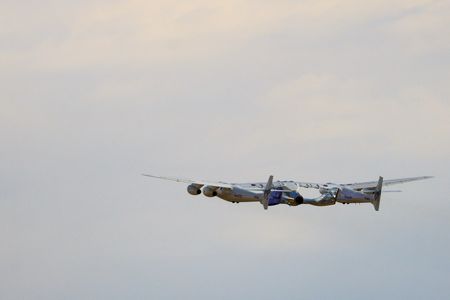By Jose Luis Gonzalez and Steve Gorman
TRUTH OR CONSEQUENCES, New Mexico (Reuters) -A three-man crew from Italy soared more than 50 miles (80 km) above the New Mexico desert on Thursday aboard a Virgin Galactic rocket plane, the company’s first flight of paying customers to the edge of space since British billionaire Richard Branson founded the venture in 2004.
The two Italian air force officers and an aerospace engineer from the National Research Council of Italy made the brief suborbital ride with three Virgin Galactic crew members, two of whom piloted the vehicle, VSS Unity, once it was launched at high altitude from the belly of its twin-fuselage carrier plane.
About 75 minutes after leaving the ground with its mothership, the Unity spaceplane safely glided back to its starting point on a runway at Spaceport America, a state-owned complex near the aptly named New Mexico town of Truth or Consequences. Virgin Galactic leases part of the facility.
The flight marked a long-delayed breakthrough for Virgin Galactic Holding Inc, finally inaugurating commercial service after nearly 20 years fraught by development setbacks.
Branson founded the company with renowned aerospace mogul Burt Rutan in a venture that grew out of the 2004 Ansari X Prize competition won by Rutan’s experimental spaceplane – forerunner of the SpaceShipTwo design of Unity.
Virgin becomes the latest commercial enterprise, along with Jeff Bezos’s Blue Origin and fellow billionaire Elon Musk’s SpaceX, catering to wealthy customers willing to pay large sums of money to experience the exhilaration of supersonic rocket speed, microgravity and the spectacle of the Earth’s curvature from space.
ITALIAN SCIENCE MISSION
The “Galactic 01” mission of the Italian team flying on Thursday, however, was billed as a scientific one, with the three men planning to collect biometric data, measure cognitive performance and record how certain liquids and solids mix in microgravity conditions.
For Italian Air Force Colonel Walter Villadei the flight was also part of his astronaut training for a future mission to the International Space Station.
Joining him on Thursday were two Italian colleagues – Air Force Lieutenant Colonel Angelo Landolfi, a physician and flight surgeon, and Pantaleone Carlucci, a research council member acting as flight engineer and payload specialist.
Rounding out the crew was their Virgin Galactic trainer, Colin Bennett, the company’s lead “astronaut instructor,” and Unity’s two pilots, Michael Masucci and Nicola Pecile.
The gleaming white rocket plane was borne aloft at around 10:30 a.m. EDT (14300 GMT) attached to the underside of its transport jet, VMS Eve, as the carrier plane took off from Spaceport America near the New Mexico town of Truth or Consequences.
Reaching its launch-altitude point roughly 45,000 feet (8.5 miles/13.68 km) above the ground, Unity was then released from the mothership and fell away as the pilots ignited the vehicle’s engine to send the rocket plane streaking in a near-vertical climb at about three times the speed of sound to the blackness of space.
Virgin Galactic said Unity topped out its flight at an altitude of nearly 52.9 miles (85.1 km).
At the apex of the flight, with the rocket shut down, the crew then experienced a few minutes of weightlessness before the craft shifted into re-entry mode and began its gliding descent back to Earth.
A Virgin Galactic webcast showed live footage of crew members strapped into their seats in flight suits and sunglasses as they neared the height of their voyage, then enjoying the thrill of microgravity as Villadei unveiled an Italian flag in the cabin.
EVOLVING BUSINESS MODEL
The flight came two years after Branson himself rode along with five other Virgin Galactic personnel for the first fully crewed test spaceflight of Unity in July 2021. At the time, the company was targeting regular commercial service to begin in 2022 following additional test flights.
But completion of the test program took longer than anticipated after federal regulators grounded Unity for 11 weeks while the company was under investigation for deviating from its assigned airspace on ascent during the July 2021 flight. A final crewed test flight to space was conducted with little fanfare five weeks ago.
The company had said before Thursday’s launch that a successful flight would pave the way for Unity to fly again in early August, with monthly flights thereafter.
Virgin Galactic has said it has already booked a backlog of some 800 customers, charging most from $250,000 to $450,000 per seat, and envisions eventually building a large enough fleet to accommodate 400 flights annually.
Establishing a solid safety record is critical. An earlier prototype of the Virgin Galactic rocket plane crashed during a test flight over California’s Mojave Desert in 2014, killing one pilot and seriously injuring another. Passengers are required to sign a pre-flight waiver acknowledging the risks and lack of government regulation over space tourism.
How high one goes to experience what is considered true spaceflight may also factor into the equation.
Bezos, whose astro-tourist venture Blue Origin has already flown several commercial passenger flights, has disparaged Virgin as falling short of the mark.
Unlike Unity, Bezos has said, Blue Origin’s suborbital New Shepard rocketship tops the 62-mile-high-mark (100 km), called the Karman line, set by an international aeronautics body as defining the boundary between Earth’s atmosphere and space.
NASA and the U.S. Air Force both define an astronaut as anyone who has flown 50 miles (80 km) high or more.
(Reporting by Jose Luis Gonzalez in Truth or Consequences, New Mexico, and Steve Gorman in Los Angeles; Editing by Will Dunham, Nick Zieminski and Chizu Nomiyama)





